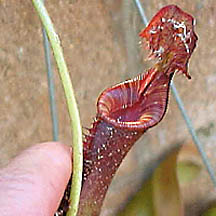
In the Garden![]()
Michael Miyashiro
Growing highland
nepenthes
Almost every text on the subject of growing highland nepenthes states that you need the correct climate and temperatures to grow these plants well. New evidence shows that some highlands can be grown at intermediate to lower altitudes and still produce lovely plants.

|
I've been growing nepenthes off and on for almost 10 years, mostly off, due to the fact that many of the desired highland species wouldn't grow here -- until I received some plants from a friend who sent me, by mistake, a few highland species. I was shocked and e-mailed him to say that he sent them to their deaths by sending them to me in warm Hawaii. He said that these actually grew better for him in a warm house over a cool one.
So like a true plant nut, I potted them up in my usual mix (mostly peat moss at the time) and placed them in my greenhouse. I watered them and treated them special. Then one day, I noticed a strange coloring coming from an area where they were supposed to be only green. I almost walked into the wall when this strange coloring came from a pitcher of a Nepenthes lowii. It had all of the characteristics of those grown high atop a volcano.
I've been nepenthes-crazy ever since. So far, I have grown Nepenthes spathulata, veitchii, alata, maxima, tobaica and many others and their hybrids with ease. Some tend to grow slowly, but most grow over time so you can enjoy the many beautiful pitchers they produce.
Their culture is surprisingly similar to growing orchids. I primarily use a variation including peat moss, coconut husk chips and New Zealand sphagnum moss. I have also used perlite, vermiculite, fir bark, potting mixes and even live moss. But I tend to go back to something that drains freely and dries out somewhat in between watering.
Daily watering is essential for growing them successfully. Water should drain freely out of their drain holes and not collect so that roots stay wet. They are especially fond of rain and love it when downpours soak their roots and they're allowed to bathe all day and night in rain.
When orchids are already rotten at this point, nepenthes usually sprout out major growths after such a downpour. Many will grow very well in near to full sunlight. If your plant has been growing in deep shade all of its life, a gradual exposure to bright light is necessary to prevent it from burning. While most of my plants show older leaves with many a brown sunburn spot, all of their newer growth has usually rewarded me with thick, leathery, succulent leaves and pitchers.
Move over, orchids, now there's a nemesis that will take over your space and add charm and beauty and at the same time make a meal of unwanted insect pests!

